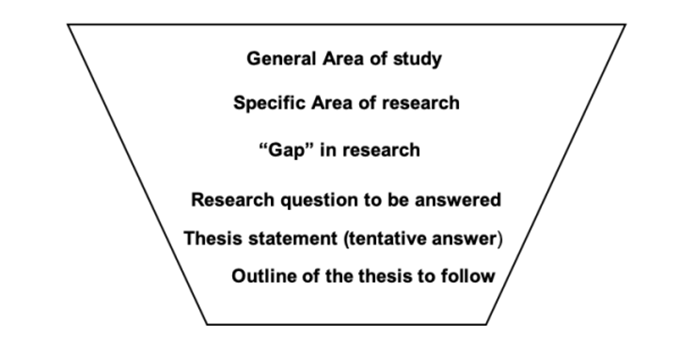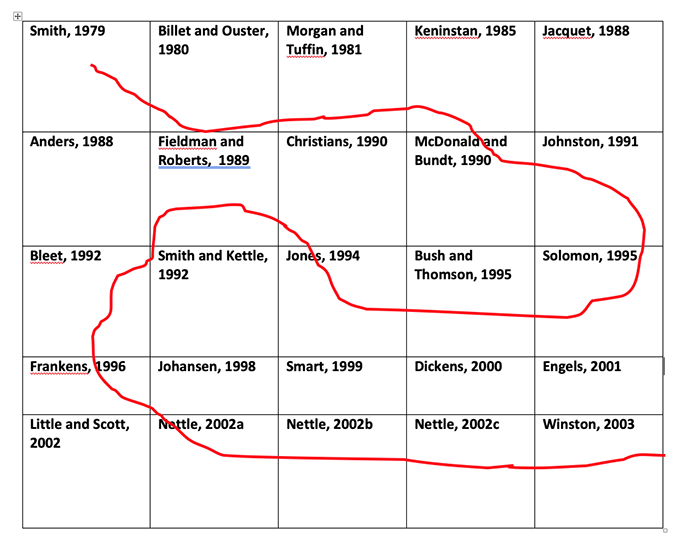
What distinguishes a PhD from an airport novel, a corporate annual report, a parliamentary submission, a comic, or a racy Mills and Boon romance novel? They are all writing genres, but they are all very different. The defining requirement of a PhD is finding, articulating, and filling a research gap (hereafter, The Gap). Without this, the purported thesis is a mere collection of words discussing a topic. And this is never enough for a PhD.
But how does The Gap fit into your overall thesis? What is its job? How does it relate to the thesis outline, the introduction, body and other key thesis components? Importantly, how do you find one? These questions are seldom answered to the satisfaction of newbie PhD students.
Finding, articulating and filling “The Gap” is critical to thesis writing and marks it as a distinct writing genre. You can get to The Gap by thinking of the process as a series of narrowing “conversations”:
- The general area is a particular conversation among academics in the field of study
- The specific area is your focus on a particular part of the bigger conversation (a sub-set of the larger conversation)
- The Gap is what you notice needs to be said in the conversation that has not been said before or that needs addressing in more detail
- The research question/hypothesis/aim asks something to address The Gap in the conversation
- The thesis statement is your proposed answer to this question posed to address The Gap in the conversation (or tentativeanswer if you are at Research Proposal stage).
- To this we can add a ThesisOutline: a courtesy statement or statements to the reader of where your thesis is going and the shape and structure it is going to take. (You owe them this if they are going to plough through 80-100,000 words for you.)
All this can be viewed as an increasingly narrowing triangle moving from the general topic to the specific issue, thence to The Gap, as illustrated in the diagram below:

A common question might be how “The Gap” relates to the Literature Review of the thesis. Your literature review has to be effectively in two parts:
-
- The first part—the Introduction—provides sufficient reviewing of the literature to establish that The Gap is significant and worth investigating (otherwise they won’t read further). I call this the “Hook literature”.
- The second part—the Literature Review proper—elaborates on the literature to further expose The Gap addressed in the Introduction. This expands on the Hook literature in much more detail (i.e., at chapter length).
Here’s a good example of the “Gap” in context. The gap is highlighted in bold and is followed by the thesis outline sentence and the thesis statement sentence:
Prior research draws on the diffusion of innovation framework to explain organizations’ innovation and innovation-related behaviour (see for instance, Rogers, 1983; 1995). This framework has received widespread validation using different types of innovations, and is referred to as the traditional framework of innovation diffusion (Gallivan, 2001). Attewell (1992) and Gallivan (2001) criticize the diffusion of innovation theory, arguing that it does not explain the pattern of the actual use of complex technology. This is because the main focus of this traditional framework is on factors which lead to the adoption of IT. Moreover, Attewell (1992) emphasizes the role of organizational learning and knowledge discovery to successfully implement and use complex technology. A few studies have recently begun to incorporate Attewell’s suggestion to investigate IT assimilation as an organizational learning process (see, for instance, Fichman and Kemerer 1997; Boynton et al. 1994; Armstrong and Sambamurthy 1999). These studies draw mainly on Absorptive Capacity Theory. However, there are three main problems with these studies(1)They fail to meet one of the main conditions of the absorptive capacity theory, that is the intensity of effort(2) They use a static perspective on organizational knowledge. Such an approach is criticized in the knowledge management literature (Nonaka 1994; Cook and Brown 1999). (3) They provide inconclusive evidence about the role of the top management team on IT assimilation. (OUTLINE)
These three problems will be discussed in detail in the next section.This study will overcome these problems by explicitly considering knowledge creation mechanisms. It will be argued that knowledge creation mechanisms will allow for a real test of the absorptive capacity theory. These mechanisms will enable the dynamic process of organizational knowledge to be captured, and to clarify the role of the top management team in the organizational IT assimilation journey. (THESIS OUTLINE) The remainder of this thesis is organized as follows. Section two discusses the motivation for the study. Section three discusses the theory development and research model. Section four develops the hypotheses. Section five describes the research method, sample, operationalisation of the constructs and measurement of the variables, and data analysis strategy.
Naturally, the hardest part of thesis writing is finding The Gap. It can take years! Fortunately, some tricks and techniques can help.
One is the Tracing a Path technique. On a piece of A3 paper draw a series of boxes. Each box contains name(s) from the scholarly literature, e.g., Jones and Harris (2013); Jamerson (2012); Fredrickson (1999), and so on. Once you are done draw a considered red line through the boxes, as in the image below:

If your considered red line goes through the middle of one of the boxes, you are heavily drawing on that literature for your thesis. If it scrapes the edge of a box you are marginally focussing on it. If it bypasses a box entirely it is not central to your interests. Then group the literature. Discard the literature that is not relevant to what you are doing. Now work backwards to find The Gaps are in the literature you have assembled. Choose one that is academically interesting. Repeat as often as required, and as your reading becomes more focussed.
Another approach is the Venn Diagram technique. Plot your interests as a series of concentric intersecting circles as show below. The circles ideally represent narrowly-focussed areas of study (not broad fields like “Education”). Keep doing this until you know where you project intersects with the literature on the various areas indicated by each circle. Use as many circles as you need. (I owe these examples to Natalie Bowker from Massey University.) You should be able to put a cross where you are working, and this will form the major literature for your thesis, and the focus for your Gap-finding activities, see the diagram below:

Another technique is the Page 98 Paper technique (so described as it is on this page of Rowena Murray’s 2002 book: How to Write a Thesis). The idea here to write a cryptic one-pager encompassing all of the following elements
- The general topic is … (25 words)
- My research question is … (50 words)
- Researchers who have looked at this subject are … (50 words)
- They argue that … (25 words)
- Smith argues that … (25 words)
- Brown argues that … (25 words)
- Debates centre on the issue of … (25 words)
- There is still work to be done on …(25 words)
- My research is closest to that of X in that … (50 words)
- My contribution will be that … (50 words)
The Gap is [8] of course, but this can’t be understood independently of surrounding context. The strategy of the Page 98 Paper is that colleagues, supervisors and significant others are more likely to read a thesis in miniature than a weighty chuck of a chapter. But it is also useful for Gap-finding as it forces you to find one.
The Table of Contents Technique requires a bit of positive imagery. (It’s best tried with a glass of your favourite tipple.)
Imagine a few years from now when your thesis is done and dusted. (You can be early in the first year of your candidature for this technique to work as long as you have done a bit of reading.) Now imagine your thesis has been through the examination process. You did well. The reports are outstanding. Now, imagine how the Table of Contents looks on this fine piece of work.Write it down just as you imagine itcomplete with major parts, sections and sub-sections (include sub-sub-sections if you like—within reason).
Now work backwards and establish where The Gap is amongst all the assembled headings and sub-headings in this highly structured masterpiece of scholarship. There must be one or it would not hang together! Do this as often as required, and at minimum every six months or so while you are writing your thesis. (I established my final Table of Contents on the island of Crete whilst on a doctoral travelling junket. I took a dip in the Med just to celebrate.)
Variation: Write down all your headings and sub-headings on small cards. Shuffle the cards. Now, put the cards in a natural order as though you were explaining their arrangement to an uninformed friend. What’s The Gap you are filling? Again, there must be one for this order to make sense.
Author Bio: Associate Professor Martin Davies is Principal Fellow in Higher Education in the Melbourne Graduate School of Education and a Senior Learning Advisor working with HDRs and staff at Federation University.